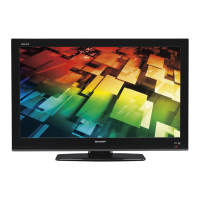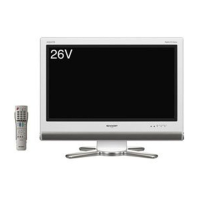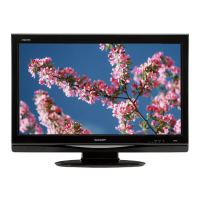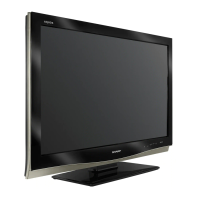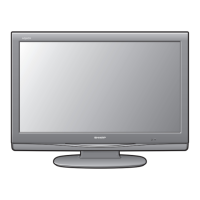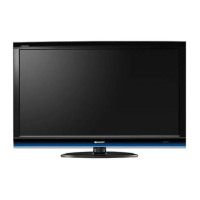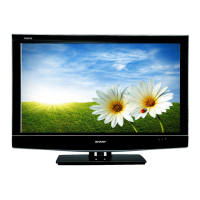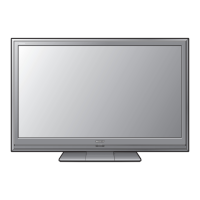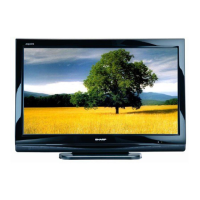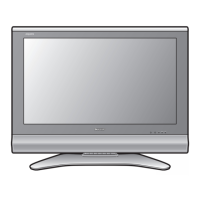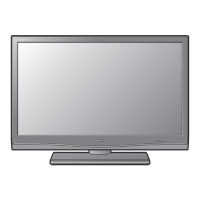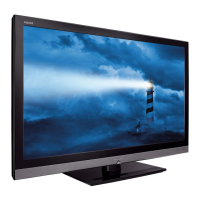Do you have a question about the Sharp Aquos LC-32D53X and is the answer not in the manual?
Advice on how to carry the TV safely to prevent damage or injury.
Instructions for installing batteries into the remote control unit.
Guidance on how to operate the remote control unit effectively.
Important warnings and precautions for using the remote control unit.
Step-by-step instructions for attaching the TV stand securely.
Guidance on placing the TV and connecting cables, including AC cord and antenna.
Explains how to connect the TV to an antenna and AC outlet for basic operation.
Instructions for wall-mounting the TV using an optional bracket, including safety precautions.
Procedure for safely removing the TV stand, typically for wall mounting.
Identifies and labels the various buttons and sensors on the front of the TV.
Details the various input and output terminals located on the rear of the TV.
Illustrates and labels the buttons on the remote control unit.
Steps for powering the TV on from standby mode using the remote or TV controls.
Instructions for turning the TV off and placing it into standby mode.
Methods for changing TV channels using remote control buttons like CH/V.
How to use the Flashback button to switch between the previously tuned channel.
Explains how to select different sound multiplex modes (NICAM, STEREO, MONO, Bilingual).
How to adjust volume and use the mute function with simple button operations.
Guide on setting the sleep timer to automatically switch the TV to standby.
Details the function of the ANALOG, DTV, and RADIO buttons on the remote control.
Explains the function of the MENU, navigation, and ENTER buttons for menu operations.
Describes the on-screen display elements and their meanings during menu navigation.
Procedure for automatically scanning and setting up channels for analogue TV.
Guide to setting up TV programmes, including auto search and manual tuning.
Details the process of automatically searching for and downloading TV channels.
How to manually set individual channel parameters like Search, Fine tuning, Colour system, etc.
Instructions for fine-tuning the frequency of a selected channel for optimal picture quality.
Explains how to select the appropriate colour system (PAL, SECAM, NTSC) for the input signal.
Continues manual channel settings, focusing on Sound System and Skip options.
How to select the correct sound system (e.g., B/G, D/K, M) for broadcasting signals.
Procedure to skip channels so they are bypassed when changing channels.
Allows sorting of channel positions freely on the TV.
Instructions for labelling channels freely to assign custom names.
How to erase individual programmes from the channel list.
Selecting predefined AV modes (Standard, Movie, Game, PC, User, Dynamic) for optimal viewing experience.
Automatically adjusts screen brightness based on ambient lighting conditions.
How to use the OPC function via the TV's menu system for automatic brightness adjustment.
Guide to adjusting various picture settings like brightness, contrast, colour, and sharpness.
Accessing advanced picture settings for more detailed image customization.
Adjusting the colour temperature to achieve the best white image balance.
Enhancing fast-action video clarity by reducing motion blur.
Automatically optimises picture quality for film-based content.
Adjusting dark portions of the image for improved viewing depth.
Improves image quality by reducing dot crawl and cross colour noise.
Enables viewing video content in monochrome (black and white).
Customizing sound quality by adjusting treble, bass, balance, and surround settings.
Enables surround sound effects for a more immersive audio experience.
Settings for managing power consumption, including No Signal Off and No Operation Off.
Automatically shuts down the TV if no operation occurs for 3 hours.
Lists the menu items available when the TV is in DTV input mode.
Instructions on how to select and access the DTV mode for digital broadcasts.
Explanation of the Electronic Programme Guide (EPG) and its features for DTV.
Step-by-step guide to finding and selecting programmes using the EPG.
How to search for and view programme information for the following day using the EPG.
How to check the schedule of DTV events and view detailed programme information.
Creating and accessing a list of favorite TV channels.
How to view extended programme information for the current or next programme.
Selecting desired programmes from the organized programme list.
Assigning channels to favorite lists or locking them for parental control.
Setting parental controls to restrict access to certain TV channels based on content ratings.
Initial setup procedure for the TV receiver, including program list population.
Automatically scans for and downloads all available TV channels.
Manually adjusting individual channel settings such as frequency and signal quality.
Scanning DTV channels quickly based on city or region selection.
Selecting the output format for video signals, such as 1080i or auto.
Clearing all channel data and returning settings to default.
Selecting the audio output system for digital audio signals (PCM or Dolby Digital).
Selecting different audio languages for broadcasts with multiple language options.
Setting the local time zone for accurate time display.
Configuring display time and format for the information plate.
Setting a 4-digit password to protect TV settings from unauthorized changes.
Procedure to register a new 4-digit password for child lock.
How to reset the child lock password if it is forgotten.
Skipping specific inputs (HDMI, PC) during input selection.
Assigning custom labels to input sources for easier identification.
Adjusting the horizontal and vertical position of the displayed image.
Automatically switching screen formats based on WSS signals.
Selecting between Panorama and Normal aspect ratios based on WSS signals.
Configuring standby mode for quick start-up or energy conservation.
Manually selecting wide screen modes (Normal, Zoom, Panorama, Full) for TV/AV inputs.
Selecting screen sizes (Normal, Full) for PC input mode.
Selecting the display language for menus and on-screen information.
Demonstrates the Fine Motion Advanced feature for picture quality improvement.
Reducing video noise to produce a clearer image.
Selecting the input source (TV, INPUT 1-5) for external equipment.
Setting the signal type (Auto, Component, S-Video, Video) for external equipment.
Choosing how the audio output volume is controlled (Fixed or Variable).
Setting the TV to display audio only, turning off the screen image.
Displays elapsed game time when the TV is in GAME mode.
Changing the colour system (AUTO, PAL, SECAM, NTSC) for compatible video signals.
Configuring HDMI input settings, including Auto View and Audio Select.
Setting up PC input, including input signal type and fine sync adjustments.
Manually setting the input signal type for PC input, especially for resolution compatibility.
Automatically adjusting the PC image for optimal display conditions.
Manually fine-tuning PC image position, clock, and phase for optimal display.
Allows displaying two pictures simultaneously on the screen.
Explains the Teletext service and how to access information.
Turning the Teletext mode on and off using the remote control.
Showing subtitles transmitted with programmes.
Accessing and displaying Teletext subpages.
Displaying time information embedded within Teletext broadcasts.
Setting the Teletext language for correct display of information.
Freezing a motion picture on the screen to view a still image.
Selecting output signals for external equipment connection.
General guide for displaying images from external sources like DVD, VCR.
Specific steps to display a DVD image connected to the TV.
Instructions for connecting a VCR to the TV's INPUT 1 or INPUT 2 terminals.
Steps for connecting a DVD player to various input terminals like HDMI.
How to connect game consoles and camcorders using INPUT 1 or INPUT 2.
Guide for connecting satellite receivers or cable boxes to the TV.
Connecting a PC to the TV's INPUT 5 terminal for display.
Steps to view PC images on the TV screen, including automatic signal detection.
Common problems and their solutions for TV operation.
Specific troubleshooting steps for Digital TV (DTV) reception issues.
Warnings about operating the TV in extreme temperatures to prevent damage.
Technical details for connecting and controlling the TV via RS-232C port.
Settings required for PC communication via the RS-232C port.
Steps for sending commands from a PC to the TV via RS-232C.
Format of commands sent to the TV via RS-232C for control.
Input format for parameters used in RS-232C commands.
List of PC resolutions and their compatibility with the TV.
Formats for normal and error responses received from the TV via RS-232C.
Table listing specific commands, parameters, and their effects on the TV.
Information on available optional accessories like wall mount brackets.
Advice on how to carry the TV safely to prevent damage or injury.
Instructions for installing batteries into the remote control unit.
Guidance on how to operate the remote control unit effectively.
Important warnings and precautions for using the remote control unit.
Step-by-step instructions for attaching the TV stand securely.
Guidance on placing the TV and connecting cables, including AC cord and antenna.
Explains how to connect the TV to an antenna and AC outlet for basic operation.
Instructions for wall-mounting the TV using an optional bracket, including safety precautions.
Procedure for safely removing the TV stand, typically for wall mounting.
Identifies and labels the various buttons and sensors on the front of the TV.
Details the various input and output terminals located on the rear of the TV.
Illustrates and labels the buttons on the remote control unit.
Steps for powering the TV on from standby mode using the remote or TV controls.
Instructions for turning the TV off and placing it into standby mode.
Methods for changing TV channels using remote control buttons like CH/V.
How to use the Flashback button to switch between the previously tuned channel.
Explains how to select different sound multiplex modes (NICAM, STEREO, MONO, Bilingual).
How to adjust volume and use the mute function with simple button operations.
Guide on setting the sleep timer to automatically switch the TV to standby.
Details the function of the ANALOG, DTV, and RADIO buttons on the remote control.
Explains the function of the MENU, navigation, and ENTER buttons for menu operations.
Describes the on-screen display elements and their meanings during menu navigation.
Procedure for automatically scanning and setting up channels for analogue TV.
Guide to setting up TV programmes, including auto search and manual tuning.
Details the process of automatically searching for and downloading TV channels.
How to manually set individual channel parameters like Search, Fine tuning, Colour system, etc.
Instructions for fine-tuning the frequency of a selected channel for optimal picture quality.
Explains how to select the appropriate colour system (PAL, SECAM, NTSC) for the input signal.
Continues manual channel settings, focusing on Sound System and Skip options.
How to select the correct sound system (e.g., B/G, D/K, M) for broadcasting signals.
Procedure to skip channels so they are bypassed when changing channels.
Allows sorting of channel positions freely on the TV.
Instructions for labelling channels freely to assign custom names.
How to erase individual programmes from the channel list.
Selecting predefined AV modes (Standard, Movie, Game, PC, User, Dynamic) for optimal viewing experience.
Automatically adjusts screen brightness based on ambient lighting conditions.
How to use the OPC function via the TV's menu system for automatic brightness adjustment.
Guide to adjusting various picture settings like brightness, contrast, colour, and sharpness.
Accessing advanced picture settings for more detailed image customization.
Adjusting the colour temperature to achieve the best white image balance.
Enhancing fast-action video clarity by reducing motion blur.
Automatically optimises picture quality for film-based content.
Adjusting dark portions of the image for improved viewing depth.
Improves image quality by reducing dot crawl and cross colour noise.
Enables viewing video content in monochrome (black and white).
Customizing sound quality by adjusting treble, bass, balance, and surround settings.
Enables surround sound effects for a more immersive audio experience.
Settings for managing power consumption, including No Signal Off and No Operation Off.
Automatically shuts down the TV if no operation occurs for 3 hours.
Lists the menu items available when the TV is in DTV input mode.
Instructions on how to select and access the DTV mode for digital broadcasts.
Explanation of the Electronic Programme Guide (EPG) and its features for DTV.
Step-by-step guide to finding and selecting programmes using the EPG.
How to search for and view programme information for the following day using the EPG.
How to check the schedule of DTV events and view detailed programme information.
Creating and accessing a list of favorite TV channels.
How to view extended programme information for the current or next programme.
Selecting desired programmes from the organized programme list.
Assigning channels to favorite lists or locking them for parental control.
Setting parental controls to restrict access to certain TV channels based on content ratings.
Initial setup procedure for the TV receiver, including program list population.
Automatically scans for and downloads all available TV channels.
Manually adjusting individual channel settings such as frequency and signal quality.
Scanning DTV channels quickly based on city or region selection.
Selecting the output format for video signals, such as 1080i or auto.
Clearing all channel data and returning settings to default.
Selecting the audio output system for digital audio signals (PCM or Dolby Digital).
Selecting different audio languages for broadcasts with multiple language options.
Setting the local time zone for accurate time display.
Configuring display time and format for the information plate.
Setting a 4-digit password to protect TV settings from unauthorized changes.
Procedure to register a new 4-digit password for child lock.
How to reset the child lock password if it is forgotten.
Skipping specific inputs (HDMI, PC) during input selection.
Assigning custom labels to input sources for easier identification.
Adjusting the horizontal and vertical position of the displayed image.
Automatically switching screen formats based on WSS signals.
Selecting between Panorama and Normal aspect ratios based on WSS signals.
Configuring standby mode for quick start-up or energy conservation.
Manually selecting wide screen modes (Normal, Zoom, Panorama, Full) for TV/AV inputs.
Selecting screen sizes (Normal, Full) for PC input mode.
Selecting the display language for menus and on-screen information.
Demonstrates the Fine Motion Advanced feature for picture quality improvement.
Reducing video noise to produce a clearer image.
Selecting the input source (TV, INPUT 1-5) for external equipment.
Setting the signal type (Auto, Component, S-Video, Video) for external equipment.
Choosing how the audio output volume is controlled (Fixed or Variable).
Setting the TV to display audio only, turning off the screen image.
Displays elapsed game time when the TV is in GAME mode.
Changing the colour system (AUTO, PAL, SECAM, NTSC) for compatible video signals.
Configuring HDMI input settings, including Auto View and Audio Select.
Setting up PC input, including input signal type and fine sync adjustments.
Manually setting the input signal type for PC input, especially for resolution compatibility.
Automatically adjusting the PC image for optimal display conditions.
Manually fine-tuning PC image position, clock, and phase for optimal display.
Allows displaying two pictures simultaneously on the screen.
Explains the Teletext service and how to access information.
Turning the Teletext mode on and off using the remote control.
Showing subtitles transmitted with programmes.
Accessing and displaying Teletext subpages.
Displaying time information embedded within Teletext broadcasts.
Setting the Teletext language for correct display of information.
Freezing a motion picture on the screen to view a still image.
Selecting output signals for external equipment connection.
General guide for displaying images from external sources like DVD, VCR.
Specific steps to display a DVD image connected to the TV.
Instructions for connecting a VCR to the TV's INPUT 1 or INPUT 2 terminals.
Steps for connecting a DVD player to various input terminals like HDMI.
How to connect game consoles and camcorders using INPUT 1 or INPUT 2.
Guide for connecting satellite receivers or cable boxes to the TV.
Connecting a PC to the TV's INPUT 5 terminal for display.
Steps to view PC images on the TV screen, including automatic signal detection.
Common problems and their solutions for TV operation.
Specific troubleshooting steps for Digital TV (DTV) reception issues.
Warnings about operating the TV in extreme temperatures to prevent damage.
Technical details for connecting and controlling the TV via RS-232C port.
Settings required for PC communication via the RS-232C port.
Steps for sending commands from a PC to the TV via RS-232C.
Format of commands sent to the TV via RS-232C for control.
Input format for parameters used in RS-232C commands.
List of PC resolutions and their compatibility with the TV.
Formats for normal and error responses received from the TV via RS-232C.
Table listing specific commands, parameters, and their effects on the TV.
Information on available optional accessories like wall mount brackets.
